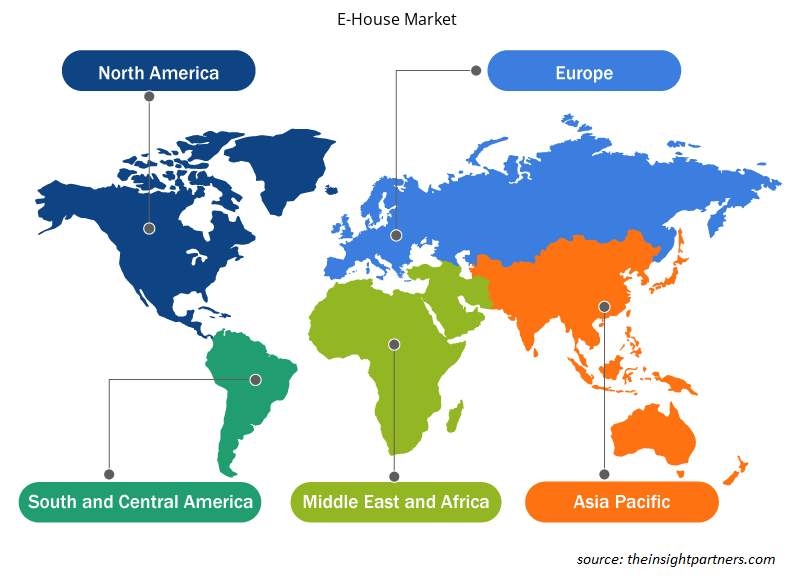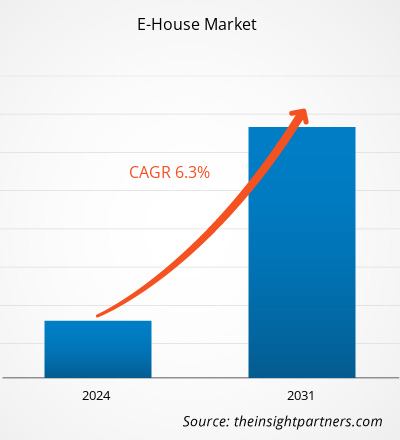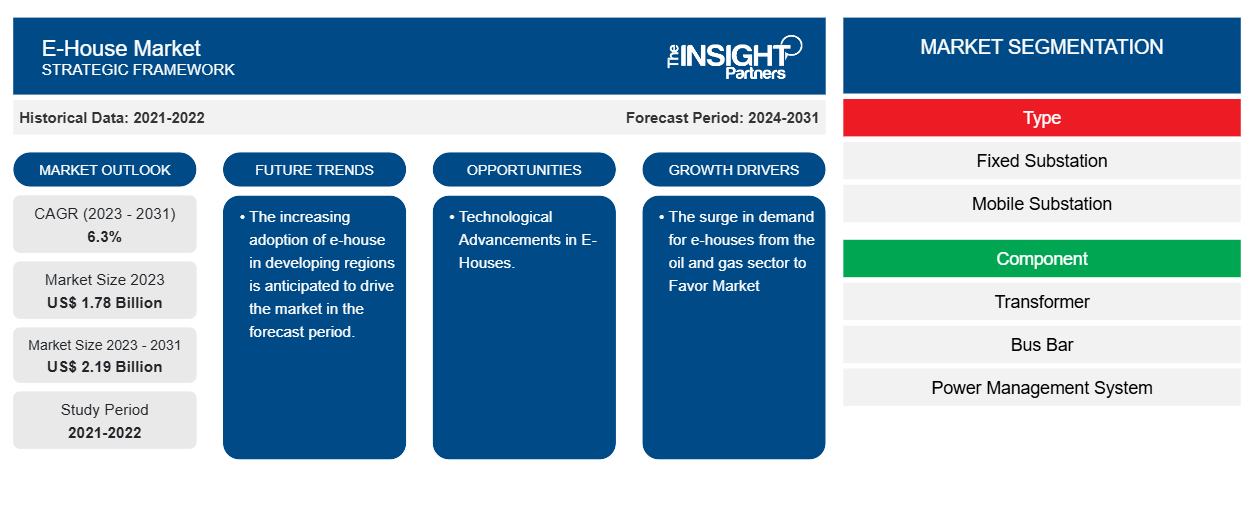Si prevede che la dimensione del mercato delle E-house raggiungerà i 2,91 miliardi di dollari entro il 2031, rispetto agli 1,78 miliardi di dollari del 2023. Si prevede che il mercato registrerà un CAGR del 6,3% nel periodo 2023-2031. La facilità di installazione, la convenienza e la flessibilità delle E-house e l'aumento della domanda di e-house da parte del settore petrolifero e del gas saranno probabilmente i principali driver e trend del mercato delle E-house.CAGR of 6.3% during 2023–2031. The ease of installation, cost-effectiveness, and flexibility of the E-House and the surge in demand for
Analisi di mercato E-House
Il mercato delle e-house sta vivendo una crescita significativa a livello globale. Questa crescita è attribuita alla facilità di installazione, alla convenienza e alla flessibilità delle e-house e all'aumento della domanda di e-house da parte del settore petrolifero e del gas. Inoltre, si prevede che l'adozione delle e-house nelle regioni in via di sviluppo e i progressi tecnologici offriranno diverse opportunità nei prossimi anni.
Panoramica del mercato E-House
Le E-house sono sottostazioni prefabbricate utilizzate come centri di distribuzione di energia. Tali sottostazioni containerizzate forniscono locali di commutazione come richiesto. Per applicazioni speciali come i Datacenter, possono essere forniti skid per una rapida distribuzione. Le E-house mobili sono installate su rimorchi come sottostazioni portatili.switchgear rooms as required. For special applications like Datacenters skids can be provided for rapid deployment. Mobile E-Houses are installed on trailers as portable substations.
Personalizza questo report in base alle tue esigenze
Riceverai la personalizzazione gratuita di qualsiasi report, comprese parti di questo report, o analisi a livello nazionale, pacchetto dati Excel, oltre a usufruire di grandi offerte e sconti per start-up e università
-
Scopri le principali tendenze di mercato in questo rapporto.Questo campione GRATUITO includerà analisi di dati che spaziano dalle tendenze di mercato alle stime e alle previsioni.
Driver e opportunità del mercato E-House
L'aumento della domanda di e-house da parte del settore petrolifero e del gas sta favorendo il mercato.
Le E-House mobili sono installate su rimorchi come sottostazioni portatili. Tutti i tipi di E-House possono risolvere varie sfide progettuali e supportare obiettivi comuni di sostenibilità. Le E-House sono distribuite in impianti di petrolio e gas upstream, midstream e downstream. Ospitano apparecchiature per la distribuzione di energia, sistemi di controllo e strumentazione fondamentali per l'estrazione, la lavorazione e il trasporto di petrolio e gas. Le E-House sono ampiamente utilizzate nel settore petrolifero e del gas e nell'industria mineraria e sempre più frequentemente per l'installazione di apparecchiature in altri settori. Pertanto, considerando i parametri di cui sopra, l'aumento della domanda di e-house da parte del settore petrolifero e del gas sta guidando il mercato.
Progressi tecnologici nelle case elettroniche.
Si prevede che il progresso tecnologico nelle e-house guiderà il mercato nei prossimi anni. Il mercato ha assistito a significativi progressi tecnologici negli ultimi anni. Questi progressi sono guidati dalla necessità di soluzioni di alimentazione più efficienti, affidabili e adattabili in una varietà di settori. Diverse aziende offrono soluzioni e-house tecnologicamente avanzate. Ad esempio, Kontrolmatik rimane all'avanguardia nei progressi tecnologici nella progettazione di E-House. L'azienda integra le ultime tecnologie intelligenti, soluzioni a risparmio energetico e sistemi di controllo avanzati per fornire soluzioni all'avanguardia ai propri clienti. Pertanto, si prevede che i progressi tecnologici nelle e-house guideranno la crescita del mercato nei prossimi anni.Kontrolmatik stays at the forefront of technological advancements in E-House design. The company integrates the latest smart technologies, energy-efficient solutions, and advanced control systems to provide cutting-edge solutions to its clients. Thus, the technology advancements in the e-houses are anticipated to drive market growth in the coming years.
Analisi della segmentazione del rapporto di mercato E-House
I segmenti chiave che hanno contribuito alla derivazione dell'analisi di mercato dell'e-house sono tipologia, componente e applicazioni.
- In base al tipo, il mercato delle e-house è suddiviso in sottostazioni fisse e sottostazioni mobili. Si prevede che il segmento delle sottostazioni fisse detenga una quota di mercato significativa nel periodo di previsione.
- In base ai componenti, il mercato E-house è suddiviso in trasformatori, barre di distribuzione, sistemi di gestione dell'alimentazione, azionamenti a frequenza variabile, apparecchiature di commutazione, HVAC e altri. Si prevede che il segmento dei trasformatori detenga una quota di mercato significativa nel periodo di previsione.switchgear, HVAC, and others. The transformer segment is anticipated to hold a significant market share in the forecast period.
- Per applicazione, il mercato è segmentato in industriale e servizi di pubblica utilità. Si prevede che i servizi di pubblica utilità manterranno una quota di mercato significativa nel periodo di previsione.
Analisi della quota di mercato di E-House per area geografica
L'ambito geografico del rapporto di mercato dell'e-house è suddiviso principalmente in cinque regioni: Nord America, Asia Pacifico, Europa, Medio Oriente e Africa, Sud e Centro America.
Il Nord America ha dominato il mercato dell'e-house. Il mercato nordamericano è segmentato in Stati Uniti, Canada e Messico. Le tendenze di adozione di tecnologie elevate in vari settori nella regione nordamericana hanno alimentato la crescita del mercato dell'e-house. Si prevede che fattori come l'adozione crescente di strumenti digitali e l'elevata spesa tecnologica da parte delle agenzie governative guideranno la crescita del mercato dell'e-house nordamericano. Inoltre, una forte enfasi sulla ricerca e sviluppo nelle economie sviluppate di Stati Uniti e Canada sta costringendo gli operatori nordamericani a portare soluzioni tecnologicamente avanzate sul mercato. Inoltre, gli Stati Uniti hanno un gran numero di operatori del mercato dell'e-house che si sono sempre più concentrati sullo sviluppo di soluzioni innovative. Tutti questi fattori contribuiscono alla crescita del mercato dell'e-house nella regione.fuelled the growth of the e-house market. Factors such as increased adoption of digital tools and high technological spending by government agencies are expected to drive the North American e-house market growth. Moreover, a strong emphasis on research and development in the developed economies of the US and Canada is forcing the North American players to bring technologically advanced solutions into the market. In addition, the US has a large number of e-house market players who have been increasingly focusing on developing innovative solutions. All these factors contribute to the region's growth of the e-house market.
Approfondimenti regionali sul mercato E-House
Le tendenze regionali e i fattori che influenzano il mercato E-House durante il periodo di previsione sono stati ampiamente spiegati dagli analisti di Insight Partners. Questa sezione discute anche i segmenti e la geografia del mercato E-House in Nord America, Europa, Asia Pacifico, Medio Oriente e Africa, e Sud e Centro America.

- Ottieni i dati specifici regionali per il mercato E-House
Ambito del rapporto di mercato E-House
| Attributo del report | Dettagli |
|---|---|
| Dimensioni del mercato nel 2023 | 1,78 miliardi di dollari USA |
| Dimensioni del mercato entro il 2031 | 2,19 miliardi di dollari USA |
| CAGR globale (2023-2031) | 6,3% |
| Dati storici | 2021-2022 |
| Periodo di previsione | 2024-2031 |
| Segmenti coperti |
Per tipo
|
| Regioni e Paesi coperti |
America del Nord
|
| Leader di mercato e profili aziendali chiave |
|
Densità degli attori del mercato E-House: comprendere il suo impatto sulle dinamiche aziendali
Il mercato E-House Market sta crescendo rapidamente, spinto dalla crescente domanda degli utenti finali dovuta a fattori quali l'evoluzione delle preferenze dei consumatori, i progressi tecnologici e una maggiore consapevolezza dei vantaggi del prodotto. Con l'aumento della domanda, le aziende stanno ampliando le loro offerte, innovando per soddisfare le esigenze dei consumatori e capitalizzando sulle tendenze emergenti, il che alimenta ulteriormente la crescita del mercato.
La densità degli operatori di mercato si riferisce alla distribuzione di aziende o società che operano in un particolare mercato o settore. Indica quanti concorrenti (operatori di mercato) sono presenti in un dato spazio di mercato in relazione alle sue dimensioni o al valore di mercato totale.
Le principali aziende che operano nel mercato E-House sono:
- ABB Ltd
- Mangiare
- Sistemi minerari Becker AG
- Schneider Electric Italia
- Siemens AG
- PERCORRERE
Disclaimer : le aziende elencate sopra non sono classificate secondo un ordine particolare.

- Ottieni la panoramica dei principali attori chiave del mercato E-House
Notizie di mercato e sviluppi recenti di E-House
Il mercato delle e-house viene valutato raccogliendo dati qualitativi e quantitativi dopo la ricerca primaria e secondaria, che include importanti pubblicazioni aziendali, dati associativi e database. Di seguito sono elencati alcuni degli sviluppi nel mercato delle e-house:
- Hartek Power ha stretto una partnership con TP Western Odisha Distribution Limited (TPWODL), una joint venture tra TATA Power e Odisha Distribution Limited, per un mandato di due nuove sottostazioni elettriche containerizzate E-house da 33/11 KV del valore di 2,99 milioni di dollari USA, chiavi in mano. (Fonte: sito web di Hartek Power Company, agosto 2023)
Copertura e risultati del rapporto di mercato di E-House
Il rapporto “Dimensioni e previsioni del mercato E-House (2021-2031)” fornisce un’analisi dettagliata del mercato che copre le seguenti aree:
- Dimensioni e previsioni del mercato E-house a livello globale, regionale e nazionale per tutti i segmenti di mercato chiave coperti dall'ambito
- Tendenze del mercato E-house e dinamiche di mercato come driver, vincoli e opportunità chiave
- Analisi dettagliata delle cinque forze PEST/Porter e SWOT
- Analisi di mercato di E-house che copre le principali tendenze di mercato, il quadro globale e regionale, i principali attori, le normative e i recenti sviluppi del mercato
- Analisi del panorama industriale e della concorrenza che copre la concentrazione del mercato, l'analisi della mappa di calore, i principali attori e gli sviluppi recenti nel mercato dell'e-house.
- Profili aziendali dettagliati
- Analisi storica (2 anni), anno base, previsione (7 anni) con CAGR
- Analisi PEST e SWOT
- Valore/volume delle dimensioni del mercato - Globale, Regionale, Nazionale
- Industria e panorama competitivo
- Set di dati Excel
Report recenti
Testimonianze
Motivo dell'acquisto
- Processo decisionale informato
- Comprensione delle dinamiche di mercato
- Analisi competitiva
- Analisi dei clienti
- Previsioni di mercato
- Mitigazione del rischio
- Pianificazione strategica
- Giustificazione degli investimenti
- Identificazione dei mercati emergenti
- Miglioramento delle strategie di marketing
- Aumento dell'efficienza operativa
- Allineamento alle tendenze normative























 Ottieni un campione gratuito per - Mercato E-House
Ottieni un campione gratuito per - Mercato E-House